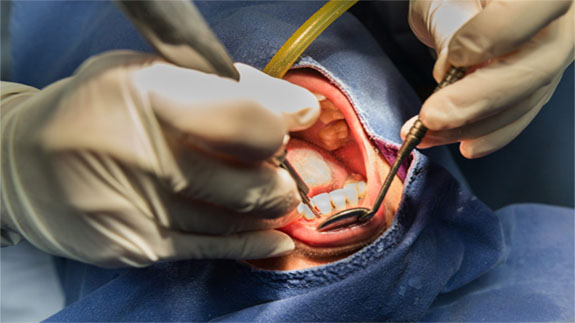ترجمه نوشته:

Root canal treatment
The root of a tooth is the hidden, essential part of the tooth, located in the gums and jawbone, and plays a key role in stability, blood supply, and sensation. Each tooth may have one or more roots, and within them are canals that contain nerves, blood vessels, and connective tissue. Damage to this sensitive tissue requires careful treatment called root canal therapy.
What is root canal treatment and why is it important?
Root Canal Therapy is one of the most important and life-saving dental procedures to preserve a natural tooth. This treatment is performed when the pulp of the tooth (the soft tissue inside the root) is inflamed, infected, or has cell death. If left untreated, the infection may spread and lead to complete tooth loss, abscesses, and even damage to the jawbone.
The scientific process of root canal treatment, step by step
Accurate diagnosis with digital imaging and examination of clinical symptoms
Local anesthesia for complete patient comfort
Access to the pulp through the tooth crown
Draining infected or dead tissue from inside the root canals
Deep disinfection with specialized chemicals and ultrasonic devices
3D filling of canals with gutta-percha and biocompatible sealers
Closing the tooth with temporary or permanent materials and finally installing a final crown to strengthen the tooth
Types of root canal treatment
Primary root canal treatment: For teeth that are first inflamed or infected
Retreatment of the root canal: In case of recurrence of infection or incomplete previous treatment
Apicoectomy: Root tip surgery is performed if non-surgical treatments are unsuccessful.
Applications of root canal therapy
Deep decay that has reached the pulp, severe infection or dental abscess, cracked or impacted teeth, teeth that still hurt after restoration.
Advantages and disadvantages of root canal treatment
Benefits: Preservation of natural teeth and prevention of extraction, immediate relief of pain and infection, restoration of tooth aesthetics and function, preservation of jaw bone structure
Possible disadvantages: Mild sensitivity for a few days, need for post-treatment veneers for greater durability
Common questions from domestic and international patients about root canal treatment
Is root canal treatment painful?
No, it is performed under anesthesia and often provides relief from the patient’s previously severe pain.
Does a treated tooth last? Yes, with proper care and a crown, it can last for years or even a lifetime.
Can root canal treatment be done in Iran?
Absolutely. Iran is one of the top destinations for dental treatments in the Middle East.
Expertise and experience of Iranian doctors in root canal treatment
Endodontists in Iran are highly educated, participate in international courses, and are proficient in the latest technologies. Root canal treatment in Iran is performed using devices such as dental microscopes, apex finders, flexible nickel-titanium files, and world-class materials.
The success rate of root canal treatment in Iran is very high, and the presence of experienced doctors has led international patients to choose Iran for their treatment with peace of mind.
Why is root canal treatment in Iran a wise choice?
Quality of treatment comparable to European and American countries, much lower cost (up to 70% reduction compared to Arab and Western countries), modern equipment and complete sterilization, calm and safe treatment environment, use of doctors specializing in root canal treatment.
Complete root canal treatment package in Iran (for international patients)
Arvan Health Tourism Group in Shiraz offers a complete root canal treatment package with the following features:
Online consultation and initial assessment, root canal treatment with the latest technology, dental crowns after root canal treatment, translation services, airport transfers, accompanying interpreter, follow-up of the patient’s condition after return.
Care after root canal treatment
Avoid chewing on the treated tooth until the final crown is placed, maintain good oral hygiene, use antibacterial mouthwashes, and visit regularly for checkups.
A pleasant therapeutic experience in the city of poetry and health; Shiraz
At Arvan Health Tourism Group, we don’t just think about root canal treatment; we invite you to a different journey. Staying in premium hotels, exploring Iranian gardens, visiting the tombs of Hafez and Saadi, ecotourism in lush villages, and enjoying authentic Shirazi cuisine such as Kalmpollo and Shirazipollo will turn a therapeutic journey into a pleasant and unforgettable memory.
General information
About root canal surgery
Anesthesia:
No
Recovery period:
Two to three days
Duration of surgery:
An hour and a half
Duration of hospitalization:
No
Return to normal life:
Same day
Cost:
-
Arvan treatment packages
Click to check Arvan packages

To book an appointment and receive a free consultation, contact us now.
Frequently asked questions about root canal treatment


Yes; the root canal process is generally mildly painful, but the level of infection and severe decay in the person's own tooth can increase this pain.
First, the dentist accesses the tooth pulp by creating a cavity, then removes the nerve and infection, cleans the tooth canal, and fills the cavity with special materials.
This cost varies depending on the type of tooth, but is generally around $130.
By maintaining good oral hygiene, using mouthwash, and taking care of your diet, you can prevent tooth nerve pain and tooth decay.
No, your tooth is actually dead and has no nerves. Therefore, it will not hurt.
Yes, if the decay recurs, you will need a repeat endodontic treatment.
Articles related to root canal treatment
✅ Complete travel guide to Qalat Village, Shiraz | A mountain tourism gem with a waterfall, church, and eco-lodge
-
Posted by
arwan.ad
- 0 comments
“Journey to the heart of Azeri culture; treatment, relaxation, and a unique experience with Arvan Health Tourism Group”
-
Posted by
arwan.ad
- 0 comments
Advantages and disadvantages of tummy tuck😱
-
Posted by
arwan.ad
- 0 comments





